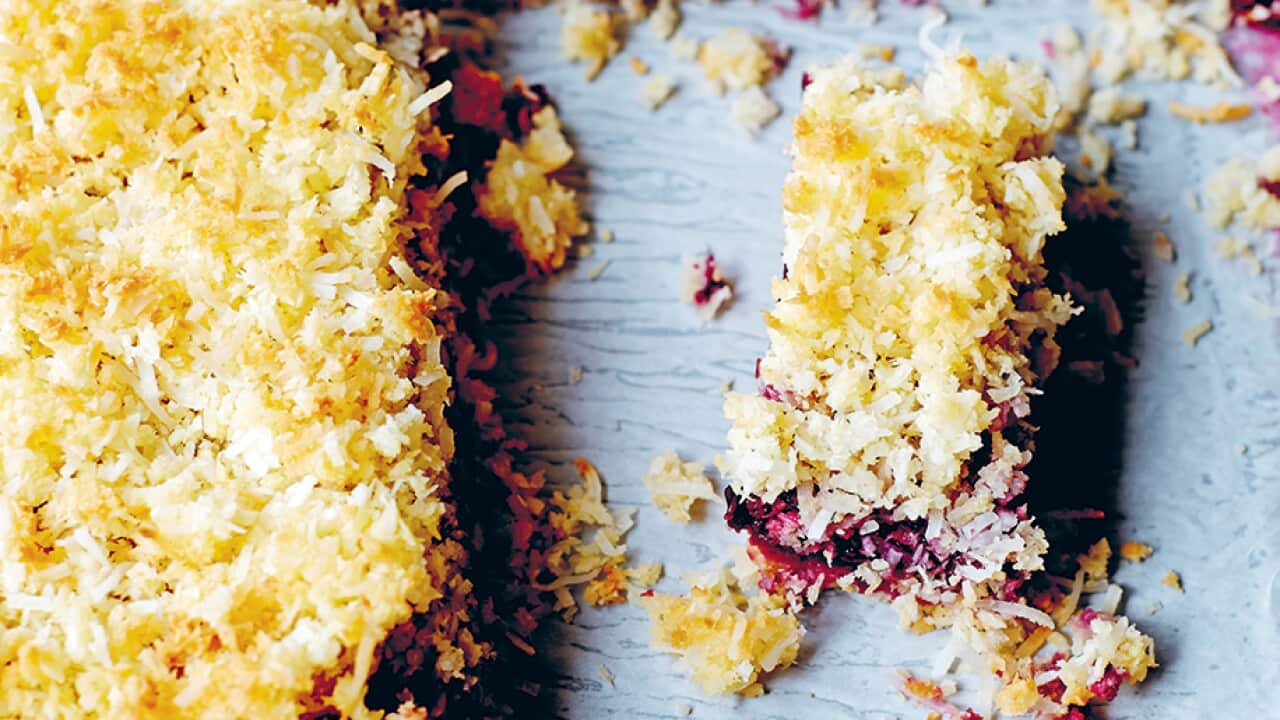Lupin, once only used as animal fodder, is a great source of gluten-free plant protein. That's good news for vegans and those with gluten problems, with lupin flour and flakes becoming more readily available. Lupin flour has even made it into pastry kitchens, thanks to its earthy flavour notes, like that of , who serves pancakes made from lupin flour at his new Pierrick Boyer Café Patisserie in Prahran, Melbourne. Boyer has experimented extensively with lupin flour and he sees its popularity growing in the future.
However, there’s a small group for whom it could potentially be an allergen.
Allergy alert
Lupins belong to the legume family and are a crop with bright yellow or white flowers harvested for the seeds or beans. They are naturally gluten free and of combined plant protein (around 40 per cent) and dietary fibre (around 30 per cent).
However, last year, Food Standards Australia New Zealand (FSANZ) added lupin to the . You see, as lupin is a legume like peanut, it is possible for .
FSANZ CEO Mark Booth says, “Historically, most of the Australian sweet lupin crop has been used for animal feed or exported. However, because of its high protein and fibre content, lupin is increasingly being used in food for people. Due to the increase in use in food and some cases of allergic response, FSANZ decided lupin should be one of the allergens requiring mandatory declaration.” According to the Australian Society of Clinical Immunology and Allergy only around and the confirmed cases of lupin allergies have been few. However, if you have a known peanut or soy allergy, it’s important to speak to your health professional before trialling lupin products.
According to the Australian Society of Clinical Immunology and Allergy only around and the confirmed cases of lupin allergies have been few. However, if you have a known peanut or soy allergy, it’s important to speak to your health professional before trialling lupin products.

Lupin flour may be the next best thing in gluten-free, healthy baking alternatives. Source: Getty Images
Lupin unearthed
Western Australia is the world’s largest producer of lupin, with a local variety called Australian Sweet Lupin (Lupinus angustifolius). Traditionally lupins were grown in Australia as a rotation crop (in between planting more valued corn, canola, wheat or oats) to enrich the soil with nitrogen. The resulting lupin beans were used as animal fodder and only became considered a human food source as research uncovered the nutritional benefits. However, the family of lupins are ancient legumes and according to of La Trobe University. “Lupin cultivars have been consumed throughout the Mediterranean region and Andean mountains for thousands of years particularly as a cold, whole bean snack,” she says. As a leader in Mediterranean Diet research, La Trobe University has been actively studying Australian sweet lupins and Kouris has been so encouraged by the nutrition status she’s introduced the flour into her own .
Traditionally lupins were grown in Australia as a rotation crop (in between planting more valued corn, canola, wheat or oats) to enrich the soil with nitrogen. The resulting lupin beans were used as animal fodder and only became considered a human food source as research uncovered the nutritional benefits. However, the family of lupins are ancient legumes and according to of La Trobe University. “Lupin cultivars have been consumed throughout the Mediterranean region and Andean mountains for thousands of years particularly as a cold, whole bean snack,” she says. As a leader in Mediterranean Diet research, La Trobe University has been actively studying Australian sweet lupins and Kouris has been so encouraged by the nutrition status she’s introduced the flour into her own .

Lupins are legumes packed with protein and fibre. They can be ground and used as a gluten-free flour. Source: Getty Images
Nutrition know-how
Like soy, lupin is rich in protein and one of a small number of plant foods with a complete set of amino acids; it is particularly rich in arginine. Commercially available as , , lupins are gluten-free, lower in carbohydrate compared to wheat counterparts and have a .
Australian sweet lupin has been shown to be phytonutrient rich and with , like lectins and saponins, which can bind calcium and zinc. Associate Professor Kouris explains that this last fact sets Australian sweet lupins apart from ancient lupin cultivars and other legumes. “Anti-nutrition compounds can also cause gut discomfort and that’s why legumes [usually] need long cooking times. However Australian sweet lupin flakes and flour can be used uncooked, such as added to smoothies or yoghurts”.
Lupins are gluten-free, lower in carbohydrate compared to wheat counterparts and have a low glycaemic index (GI) for improving blood glucose control.
Using enriched foods (at least 20 per cent lupin flour), for Australian sweet lupins in hunger or satiety management, insulin and blood glucose control, cholesterol and blood pressure lowering and improvements to gut health. In in place of some wheat flour ate 20 per cent less food and reported an increased feeling of fullness.
Cooking and baking
Lupin is making its way into supermarket food products like , people are and lupin has been trialled as a base bean in place of or in combination with soy for .
Lupin products are easy to incorporate into traditional recipes for a nutrition boost, as a substitution for breadcrumbs, wheat flour or other grain-based ingredients. starting by substituting 5-20 per cent wheat flour with lupin flour in a traditional recipe.
For gluten-free baking, Boyer suggests experimenting with combining lupin flour with other gluten-free flours. “Remember that lupin flour doesn’t need much cooking time,” he adds.
Catch Helen Tzouganatos whipping up lush gluten-free meals in the brand new first series of at 8:30pm Thursdays from 17 October to 19 December on SBS Food (channel 33), and later on SBS On Demand.







